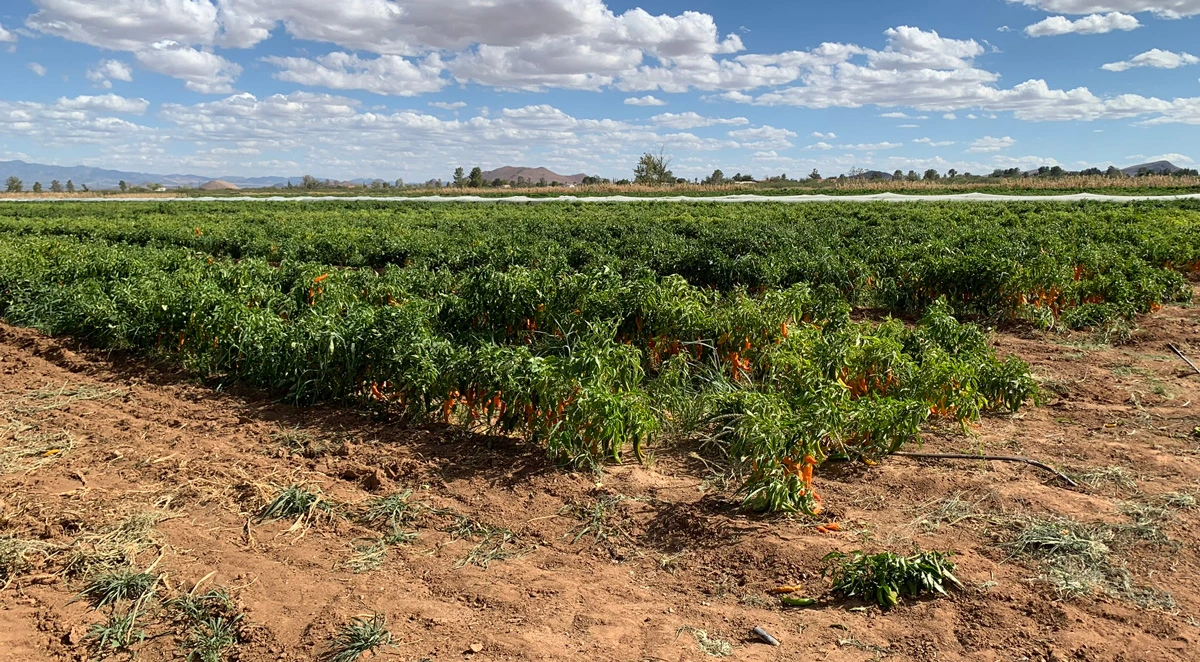
View of Curry Seed and Chile Co. in the Willcox
Groundwater Basin.
Image: Sharon B. Megdal
Groundwater is in the news. In Arizona, attention is focused on rural groundwater, and the availability of groundwater in more populated parts of the state, including the Phoenix metropolitan region, is likewise receiving attention. National news outlets have covered groundwater in Arizona and across the nation, often on dwindling supplies in the face of increasing demands. In some regions of the country and world, groundwater is seen as a buffer or back-up supply during times of drought. In Arizona and elsewhere, however, groundwater has long been a crucial water supply. On a statewide basis, groundwater comprises over 40 percent of Arizona water use, but averages can be deceiving. In many parts of Arizona, groundwater is the primary water source.
The 1980 Groundwater Management Act established the Arizona Department of Water Resources (ADWR) to implement groundwater regulations in Active Management Areas (AMAs), hydrologically defined regions that include over 80 percent of the state’s population. In designated Irrigation Non-Expansion Areas (INAs), irrigated agriculture may not expand. Elsewhere in Arizona, there are no groundwater use regulations.
The absence of a groundwater management framework for the unshaded areas in the map on the right indicates that ADWR’s only regulatory option is to declare new AMAs and INAs, a step ADWR has already demonstrated that it may take on the basis of its existing regulatory authority. In October, the department held an informational meeting in Willcox on “the deteriorating groundwater in the region.” The department’s October 3, 2024, news post noted that ADWR staff “brought groundwater data to a public meeting at the Willcox Community Center that depict plunging groundwater levels in many areas of the Willcox groundwater basin and worsening surface-level impacts from subsidence and fissuring.” Then, on October 23, 2024, ADWR issued notice of the “Director’s Order to initiate procedures to consider designating an active management area within the boundaries of the Willcox Groundwater Basin in Cochise and Graham Counties….” A recording of the hearing held on November 22, 2024, along with comments submitted in writing, can be found on ADWR’s information webpage for the Willcox Basin. Views regarding formation of a Willcox AMA are mixed. (See, for example, the article by journalist Tony Davis.) Many anxiously await ADWR Director Tom Buschatzke’s decision – and any additional actions for other groundwater basins.
Groundwater has likewise been the focus of federal policy attention. PCAST, the President’s Council of Advisors on Science and Technology, is expected to submit a report to President Biden on Improving Groundwater Security in the United States. PCAST’s November 1, 2024, meeting included discussion of a draft report prepared by PCAST’s Groundwater Working Group. Dr. Laura Condon, University of Arizona Associate Professor of Hydrology and Atmospheric Sciences, served as the external member of the working group! Recognizing the limited role of the federal government in regulating groundwater, the presentation included the following six recommendations, which were adopted by the full Council. All of the recommendations, some of which included sub-recommendations, focus on science and technology aspects of groundwater management.
Accelerate the development of a comprehensive repository for data and toolkits for groundwater storage, withdrawal, and recharge at spatial and temporal scales useful for water managers and users.
Establish a research program to advance technologies and strategies for safeguarding the future of groundwater supply and quality.
Establish a federal incentive program and network of groundwater engagement hubs, including Tribal Nations Groundwater Engagement Hubs, to support and assist planning sustainable groundwater use.
Create a competitive grants program to incentivize the planning, sustainable management, and restoration of aquifers, along with the surface waters critical to their recharge and cleanliness.
Incorporate the valuation of groundwater resources into natural capital accounting and ensure these estimates are integrated into all federal cost-benefit analyses and planning.
Launch a comprehensive campaign to recruit, develop, and retain a skilled workforce in groundwater science, management, and stakeholder engagement.
While it remains to be seen what federal actions will follow its finalization and submission, the report will underscore the role groundwater plays in meeting US water demands and the need for groundwater data. See the recently published Alley et al. Guest Editorial in Groundwater, “The Federal Role in Addressing Groundwater Depletion,” for additional perspective.
The story does not end at our national borders. The 2022 UN World Water Development Report, “Groundwater: Making the Invisible Visible,” documents groundwater’s critical role across the globe. The World Bank’s recent blog on the role of groundwater in protecting global ecosystems includes some excellent data and references. International research and policy initiatives focus on shared groundwater as well, with the United States- Mexico Transboundary Aquifer Assessment Program (TAAP) as one example. Please visit our TAAP and groundwater pages, which are both listed under the Programs tab on the WRRC’s website, for more information.
As someone who has worked extensively on groundwater management and policy, I am excited by these and other efforts to improve groundwater visibility and stewardship. I hope they lead to greater understanding and more effective management of this vital water resource.

